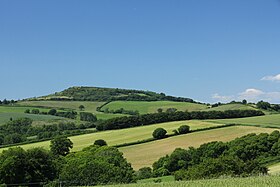Pilsdon Pen
| Pilsdon Pen | |
|---|---|

Pilsdon Pen from the southeast
|
|
| Highest point | |
| Elevation | 277 m (909 ft) |
| Prominence | 83 m |
| Listing | Tump |
| Coordinates | 50°48′23″N 2°50′04″W / 50.8065°N 2.8344°WCoordinates: 50°48′23″N 2°50′04″W / 50.8065°N 2.8344°W |
| Geography | |
| Location | West Dorset, England |
| Parent range | |
| OS grid | ST413011 |
| Topo map | OS Landranger 193 |
| Climbing | |
| Easiest route | From the car park at Lob Gate |
Pilsdon Pen is a 277-metre (909 ft) hill in Dorset in South West England, situated at the north end of the Marshwood Vale in the West Dorset administrative district, approximately 4.5 miles (7.2 km) west of Beaminster. It is Dorset's second highest point and has panoramic views extending for many miles. It was bequeathed to the National Trust by the Pinney family in 1982. For many years it was thought to be Dorset's highest hill, until modern survey revealed that nearby Lewesdon Hill was 2 metres higher.
The hill is a lower greensand Cretaceous outcrop situated amongst Jurassic strata of marl and clay, at the border between the chalk of South-East England and the granite of Devon and Cornwall.
The hill is topped by an Iron Age multivallate Durotrigian hill fort which was excavated in the 1960s by Peter Gelling of the University of Birmingham with his wife Margaret Gelling at the request of Michael Pinney. The remains of 14 roundhouses were uncovered near the centre of the hill fort. Surveys were also carried out by the National Trust in 1982 and by the Royal Commission on the Historical Monuments of England in 1995.
There are differing views as to the age of the rectilinear (square) structures in the centre of the fort (best seen in the National Trust report photo ): they may be medieval "pillow mounds" (man-made mounds for breeding rabbits), or could be earlier in origin. There is no clear evidence to distinguish the other mounds between pillow mounds and burial mounds, and the acid soil causes almost all bone and pottery to be in very poor condition.The National Trust in the 1982 excavations (which restored the mounds to their original profile prior to Gelling's excavation) viewed them as medieval; Gelling thought there was a case they were earlier. Additional rectilinear structures are noted in the 1999 National Trust Resistivity survey.
...
Wikipedia
